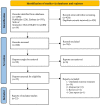Effects of white matter hyperintensity on cognitive function in PD patients: a meta-analysis
- PMID: 37621858
- PMCID: PMC10445042
- DOI: 10.3389/fneur.2023.1203311
Effects of white matter hyperintensity on cognitive function in PD patients: a meta-analysis
Abstract
Background: Parkinson's disease (PD) is often accompanied by cognitive dysfunction, which imposes a heavy burden on patients, their families, and society. Early identification and intervention are particularly important, but reliable biomarkers for identifying PD-related cognitive impairment at an early stage are currently lacking. Although numerous clinical studies have investigated the association between brain white matter hyperintensity (WMH) and cognitive decline, the findings regarding the relationships between WMH and cognitive dysfunction in PD patients have been inconsistent. Therefore, this study aims to conduct a meta-analysis of the effect of WMH on PD cognitive function.
Methods: This study was conducted in accordance with the Preferred Reporting Items for Systematic Reviews and Meta-Analyses (PRISMA) and Meta-Analysis of Observational Studies in Epidemiology (MOOSE) guidelines. We systematically searched relevant literature from databases such as PubMed, Web of Science, EMBASE, CNKI, and CBM. The retrieval time was limited to database records created up until December 31, 2022. Additionally, we manually retrieved references for full-text reading. Statistical data analysis was performed using RevMan 5.3 and Stata 15.0 software.
Results: This study encompassed 23 individual studies and involved 2,429 patients with PD. The group of PD with mild cognitive impairment (PD-MCI) exhibited a significantly higher overall level of WMH than the group of PD with normal cognitive function (PD-NC) (SMD = 0.37, 95% CI: 0.21-0.52, p < 0.01). This finding was consistent across subgroup analyses based on different ethnicities (Asian or Caucasian), WMH assessment methods (visual rating scale or volumetry), and age matching. In addition to the overall differences in WMH load between the PD-MCI and PD-NC groups, the study found that specific brain regions, including periventricular white matter hyperintensity (PVH) and deep white matter hyperintensity (DWMH), had significantly higher WMH load in the PD-MCI group compared to the PD-NC group. The study also conducted a meta-analysis of WMH load data for PD with dementia (PDD) and PD without dementia (PDND), revealing that the overall WMH load in the PDD group was significantly higher than that in the PDND group (SMD = 0.98, 95% CI: 0.56-1.41, p < 0.01). This finding was consistent across subgroup analyses based on different ethnicities and age matching. Moreover, regarding specific brain regions (PVH or DWMH), the study found that the PDD group had significantly higher WMH load than the PDND group (p < 0.01).
Conclusion: WMH was associated with PD cognitive dysfunction. The early appearance of WMH may indicate PD with MCI.
Keywords: Parkinson’s disease; cognitive impairment; dementia; meta-analysis; white matter hyperintensity.
Copyright © 2023 Zhao, Cheng, Zhu, Cui, Shen, Fu, Li, Feng and Zhang.
Conflict of interest statement
The authors declare that the research was conducted in the absence of any commercial or financial relationships that could be construed as a potential conflict of interest.
Figures












Similar articles
-
The influence of white matter hyperintensity on cognitive impairment in Parkinson's disease.Ann Clin Transl Neurol. 2021 Sep;8(9):1917-1934. doi: 10.1002/acn3.51429. Epub 2021 Jul 26. Ann Clin Transl Neurol. 2021. PMID: 34310081 Free PMC article. Review.
-
Periventricular white matter hyperintensity burden and cognitive impairment in early Parkinson's disease.Eur J Neurol. 2020 Jun;27(6):959-966. doi: 10.1111/ene.14192. Epub 2020 Mar 26. Eur J Neurol. 2020. PMID: 32124496
-
White matter hyperintensity tissue property spatial variations as a function of cognitive status in Parkinson's disease.Neuroimage. 2025 May 15;312:121236. doi: 10.1016/j.neuroimage.2025.121236. Epub 2025 Apr 23. Neuroimage. 2025. PMID: 40280215
-
Voxel-based meta-analysis of gray matter volume reductions associated with cognitive impairment in Parkinson's disease.J Neurol. 2016 Jun;263(6):1178-87. doi: 10.1007/s00415-016-8122-3. Epub 2016 Apr 25. J Neurol. 2016. PMID: 27113603
-
A systematic review and meta-analysis on the association between orthostatic hypotension and mild cognitive impairment and dementia in Parkinson's disease.Neurol Sci. 2023 Apr;44(4):1211-1222. doi: 10.1007/s10072-022-06537-3. Epub 2022 Dec 21. Neurol Sci. 2023. PMID: 36542202
Cited by
-
Leucencephalopathy in Patients with Parkinson's Disease and Deep Brain Stimulation.Mov Disord Clin Pract. 2025 Mar;12(3):340-345. doi: 10.1002/mdc3.14294. Epub 2024 Dec 4. Mov Disord Clin Pract. 2025. PMID: 39629747 Free PMC article.
-
Pathobiology of Cognitive Impairment in Parkinson Disease: Challenges and Outlooks.Int J Mol Sci. 2023 Dec 29;25(1):498. doi: 10.3390/ijms25010498. Int J Mol Sci. 2023. PMID: 38203667 Free PMC article. Review.
-
Neuroimaging and fluid biomarkers in Parkinson's disease in an era of targeted interventions.Nat Commun. 2024 Jul 5;15(1):5661. doi: 10.1038/s41467-024-49949-9. Nat Commun. 2024. PMID: 38969680 Free PMC article. Review.
References
-
- Wang LJ, Feng SJ, Nie K. Chinese guidelines for the diagnosis and treatment of mild cognitive impairment in Parkinson's disease (2020 edition). Chin J Nerv Ment Dis. (2021) 47:1–12. doi: 10.3969/j.issn.1002-0152.2021.01.001 - DOI
Publication types
LinkOut - more resources
Full Text Sources

